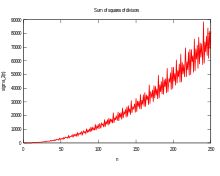Divisor function




In mathematics, and specifically in number theory, a divisor function is an arithmetic function related to the divisors of an integer. When referred to as the divisor function, it counts the number of divisors of an integer (including 1 and the number itself). It appears in a number of remarkable identities, including relationships on the Riemann zeta function and the Eisenstein series of modular forms. Divisor functions were studied by Ramanujan, who gave a number of important congruences and identities; these are treated separately in the article Ramanujan's sum.
A related function is the divisor summatory function, which, as the name implies, is a sum over the divisor function.
Definition[]
The sum of positive divisors function σx(n), for a real or complex number x, is defined as the sum of the xth powers of the positive divisors of n. It can be expressed in sigma notation as
where is shorthand for "d divides n". The notations d(n), ν(n) and τ(n) (for the German Teiler = divisors) are also used to denote σ0(n), or the number-of-divisors function[1][2] (OEIS: A000005). When x is 1, the function is called the sigma function or sum-of-divisors function,[1][3] and the subscript is often omitted, so σ(n) is the same as σ1(n) (OEIS: A000203).
The aliquot sum s(n) of n is the sum of the proper divisors (that is, the divisors excluding n itself, OEIS: A001065), and equals σ1(n) − n; the aliquot sequence of n is formed by repeatedly applying the aliquot sum function.
Example[]
For example, σ0(12) is the number of the divisors of 12:
while σ1(12) is the sum of all the divisors:
and the aliquot sum s(12) of proper divisors is:
Table of values[]
The cases x = 2 to 5 are listed in OEIS: A001157 − OEIS: A001160, x = 6 to 24 are listed in OEIS: A013954 − OEIS: A013972.
| n | factorization |
|---|




